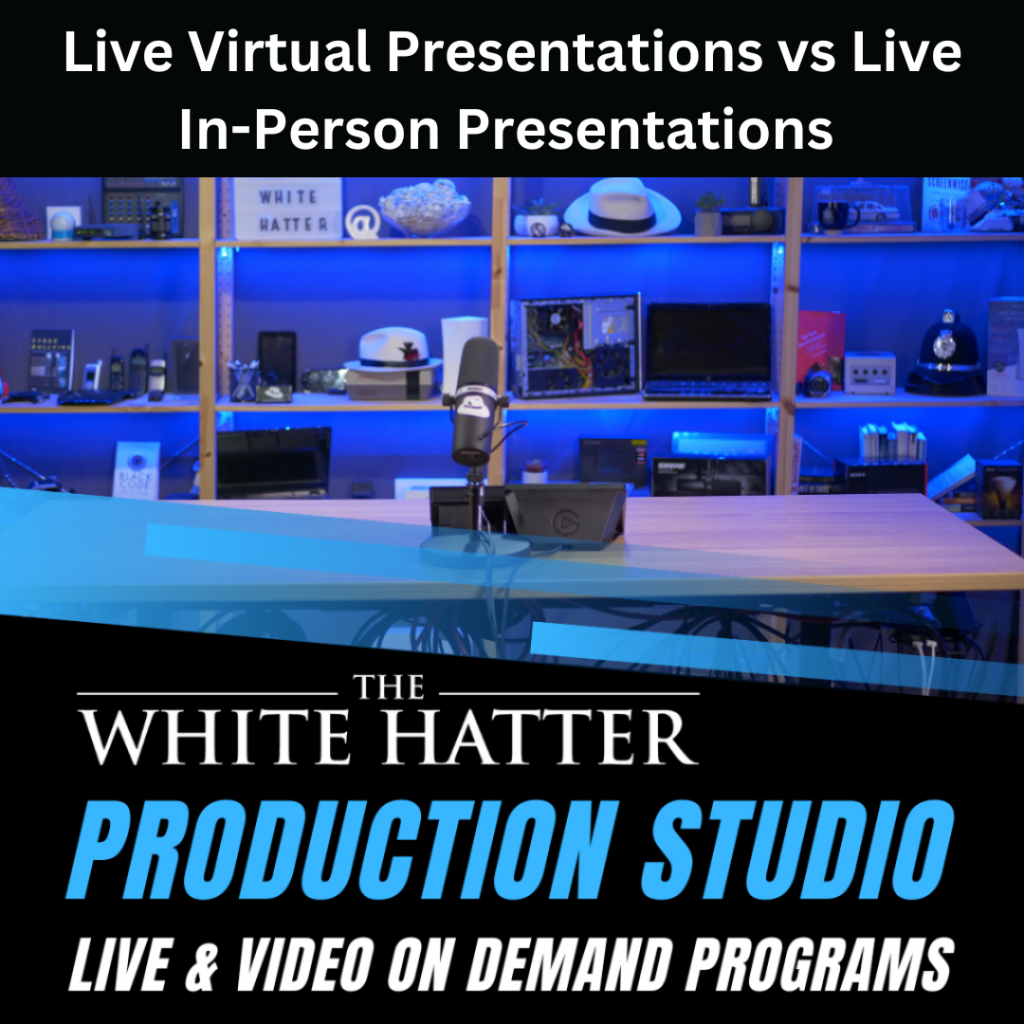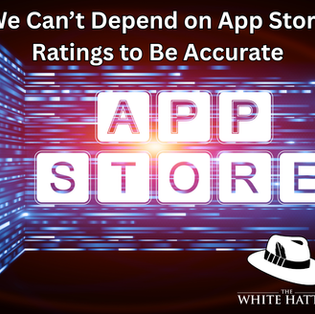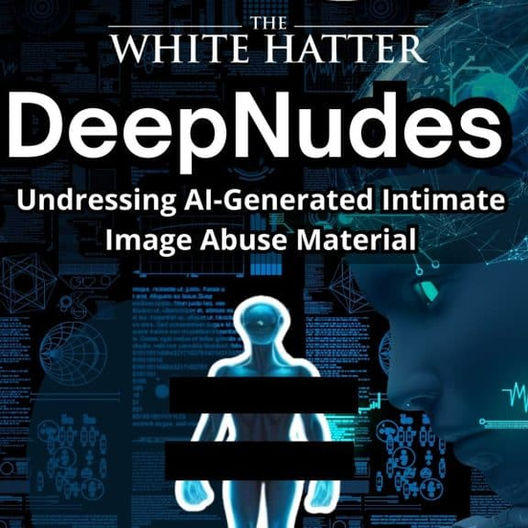Live Virtual Presentations vs. Live In-Person Presentations
- The White Hatter

- Jan 21, 2023
- 7 min read
Updated: May 6

Recently, this headline hit the media – “Zoom fatigue: Online communication less effective than in person, study suggests” (1). We have seen some presenters and educators commenting on social media that this article supports the fact that online learning is less effective than in-person learning. However, if you read the actual study (2), you will learn that it had very little to do with live in-person virtual synchronous education.
Often, we hear from educators and even other presenters that live in-person presentations are far better than live online virtual presentations - known as synchronous education in the research literature. We don’t argue that there are advantages to in-person presentations (that we do offer as an option), but are the concerns about live virtual presentations based on good research, or are they based on the anecdotal experience of the educator? Research suggests that demographic factors of educators such as gender, age, years teaching online (if any), institution type, and tenure status can influence educator perceptions and use of synchronous communication technology in their schools and classrooms as an effective learning tool. (3)(4)
When computers became popular in school, the use of technology to watch online recorded videos to enhance a teacher’s lesson plan became a common educational pedagogy. Today, there is an abundance of good research to show that the use of video on platforms such as YouTube can be an extremely effective educational tool. (5)(6)(7) In fact, PEW conducted a study where they found that 51% of YouTube users use the platform to learn new things (8)
However, given that synchronous real-time virtual education is relatively new, which became a necessity during COVID, there is not a lot of research on the educational effectiveness of live virtual presentations when compared to in-person presentations. However, we are starting to see some research emerging showing that live virtual synchronous presentations “could achieve equivalent or better student course performance than the same pre-pandemic in-person courses.”(9)
The use of live synchronous presentations in education is an under-researched and relatively new field of study. The most current research found that instructors use synchronous communication technology in various ways and that the benefits of live synchronous presentations outweigh the drawbacks (10). In our opinion, this has implications for online educators and those managing online programs, as it suggests that they should begin to intentionally integrate synchronous-based communication technology - not necessarily as a replacement for in-person education, but more as an adjunct where reasonable and appropriate to do so!
The benefits of live synchronous presentations greatly depend on how the technology is integrated and used to capture and hold the attention of students. There is no doubt that the research supports that productive and meaningful interaction with students requires intentional yet flexible facilitation during synchronous sessions, to capture as many modalities of learning as possible. Plain and simple, it is how the technology is being used that matters the most (11), and this is where many presenters and virtual programs fall short.
Many presenters are using platforms and technology that are not congruent with holding the attention of teens. Why – #1: The financial costs associated with creating the online “wow factor” of a live virtual presentation utilizing best practices can be cost prohibitive, and #2: There is a significant lack of professional training for presenters and educators on how to use technology to create an effective live in-person virtual synchronous presentation. Out of necessity, many educators and presenters turned to using Zoom and TEAMs as their primary platform to conduct live synchronous education during COVID. It should be noted; these platforms were originally designed to be “meeting spaces” and not educational platforms. However, with very little training (or no training at all) and self-ingenuity, educators and presenters were able to quickly adapt these platforms to meet their needs the best they could during very challenging times. However, due to their poor quality and lack of production value, many virtual presentations have not been well received by students and educators. These presentations were deemed inadequate in terms of their educational impact, and most were unable to capture and hold the attention of students. When we inform schools about our live virtual presentations, they often recall their previous negative experiences with virtual options, and assume that what we offer is similar, which it is not!
Here at the White Hatter, we have invested over $40,000.00 in both hardware and software to create our own live virtual broadcasting studio that would rival most TV production studios (12) - what we do is not a Zoom or TEAMs event! To be very blunt, hosting a Zoom or TEAM’s event utilizing one camera, poor lighting, a poor sound mic, and a green screen is NOT best practice when it comes to effective live in-person virtual synchronous presentations, and this is not what we do here at the White Hatter Studio. Our uniquely designed and built platform allows us to create a more interactive and immersive learning experience; purposely created to help capture and hold the attention of pre-teens, teens, and adults.
Here is some anecdotal feedback from educators about our live virtual presentations. We suggest that this feedback supports what the current but limited research has found specific to well-designed and delivered synchronous real-time virtual education:
Our virtual platform, which is based on the popular Twitch and YouTube platforms that youth enjoy, has been found to be more engaging for students compared to other platforms such as Zoom and Teams. Many have described it as "refreshing" and a high-quality interactive virtual production. Additionally, several teachers have reported that "Zoom fatigue" was not an issue with our virtual platform. A high school principal stated, "It was the slickest online presentation I have ever seen, the students and staff loved it!"
Principals and teachers have commented that the smaller classroom size in virtual presentations allows students more freedom to ask questions anonymously without fear of judgment from their peers. Our virtual platform also provides curated anonymous and interactive student questions, which both students and teachers have found to be very beneficial. The level of student engagement during the Q&A section of the virtual presentation has been notably higher compared to in-person school presentations pre-COVID. A high school teacher stated, "The number of questions was astounding, I think the anonymity really opens up the discussion"
Several schools that have seen our dynamic "in-person" presentations have now also experienced our "live dynamic and interactive virtual presentations" and have stated that they and their students prefer the delivery of our message through the live virtual presentation format. The reason being, it aligns with the digital landscape where youth and teens are today, and we take advantage of this fact by using our virtual platform to directly connect with students, which also enables them to engage with us digitally. These same schools have stated that they will continue with the live virtual presentations rather than the in-person presentations that we will continue to offer.
Most teachers reported that the smaller class size provided by the virtual presentation allowed for more in-depth discussions with their students after the event. Many teachers shared that conversations about the topics covered continued well into the next class. This is supported by the "teacher speaking notes" provided to all educators who are hosting one of our virtual events.
Both students and teachers expressed appreciation about the fact that we could not see any of the students, or collect any kind of personal information about them. Privacy by design is an important foundation of our virtual delivery platform. We cannot screen capture faces, or collect personal email addresses of students or teachers, and our platform cannot be “Bombed” by others with inappropriate video or text.
Students who found themselves at home because of illness liked the fact that they could still participate in the presentation with their class, via the White Hatter Virtual Studio Platform, thus they still felt they were a part of their class even though they were at home sick.
Our virtual presentation offered a cost-effective solution for delivering our award-winning social media safety and digital literacy programs to schools and parent groups. Given the financial constraints faced by many schools and parent-teacher associations, principals and PAC presidents have praised the reasonable cost of our virtual programs. For example, one school found that the cost of delivering three presentations live virtually was significantly less than the cost of an in-person event, due to the elimination of expenses such as travel time, lodging, and transportation.
Both educators and students, particularly at the elementary school level, have expressed a preference for participating in virtual presentations from the comfort of their classroom desks, rather than sitting on the hard floor or bleachers of a gym during assembly presentations. The comfort of the classroom setting has been identified by educators as a significant factor in maintaining student engagement during our virtual presentations.
Principals have reported increased attendance and participation by parents and caregivers in our live virtual parent presentations compared to in-person events held at their schools. Additionally, the availability of a recording of the live virtual event has ensured that parents who were unable to attend the scheduled event can still access the information at their convenience at a later date.
Now, there are some challenges that we have identified - live virtual presentations can pose challenges for schools, particularly if they lack essential equipment such as projectors, smartboards, screens, speakers, or an internet connection which are all needed to facilitate a live virtual event. In addition, buffering problems can arise due to the school's internet connection, which can make live streaming difficult. While only a few schools out of the hundreds we have virtually presented to have reported significant buffering issues, we offer a solution by providing professionally edited recorded videos, which can eliminate buffering problems often associated with a live virtual presentation.
There is no doubt that we need more evidence-based research on the strengths and weaknesses of well-designed and delivered synchronous virtual education. Based upon this research, course training standards and professional development and educational programs could also be designed and delivered to educators on how to maximize the power of live synchronous education. It has been our experience, which is supported by the limited research mentioned in this article, that well-designed and delivered online synchronous presentations can allow educators and presenters to tie into where teens are today with their use of technology, and make the educational experience more relevant to their life, and appeal to their intelligence and experience thus helping to maximize learning outcomes - it can become another effect tool in the educational toolbox for both presenters and educators if done properly!(13)(14)
Given our dedication to excellence in digital literacy and internet safety education, as well as our strategic investment in cutting-edge technology, we harness synchronous real-time live virtual education that is unique and second to none - no one else does what we do and how we do it virtually. This enables us to provide dynamic and interactive live virtual learning experiences that rival in-person presentations that resonate deeply with students.
Digital Food For Thought
The White Hatter
https://globalnews.ca/news/9415493/zoom-fatigue-online-communication-study/
https://www.sciencedirect.com/science/article/pii/S1053811922007984
https://cibgp.com/article_9383_e81004d9b09ca13e5e7063f540b82e92.pdf
https://www.frontiersin.org/articles/10.3389/fcomm.2021.581302/full
https://bmcmededuc.biomedcentral.com/articles/10.1186/s12909-021-02909-z
https://link.springer.com/article/10.1007/s10639-022-11360-6
https://link.springer.com/article/10.1186/s41239-020-00234-x
https://www.frontiersin.org/articles/10.3389/feduc.2019.00092/full














